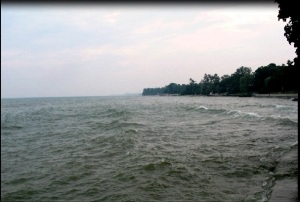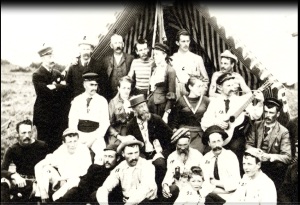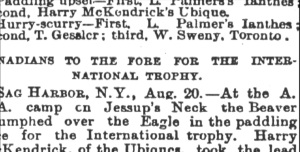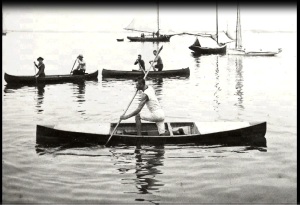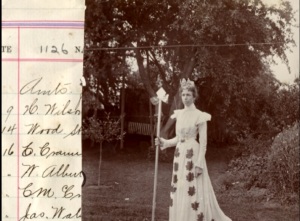
In 1954 the dying force of Hurricane Hazel caused Oakville streams to overflow.
One owner of a Lakeshore estate felt the effects keenly. Hundreds of his prize rose bushes were destroyed; decades of work erased by the flood.
After inspecting the damage, the elderly Will MacKendrick stood at the foot of his garden feeling the storm’s after-effects on the lake. The familiar vista held a lifetime of memories. He had traveled along this shoreline time and again becoming part of the intertwined history of Oakville and Toronto.
He had first come to know Lake Ontario in his youth as a competitive paddler. With his father and siblings he had traveled from Galt, in southeast Ontario, to canoe meets on both sides of the border.
Between 1886 and 1892. They made their mark as members of the Canadian group at the American Canoe Association meets.
Competitors lived in tent camps enjoying the outdoors and eating heartily when they weren’t on the water working out the rules for the emergent sport.
The list of MacKendrick wins at the 1890 World’s Championship at Jessups Neck, Long Island, New York proves their mastery of the sport.
World’s Championship paddling won by Harry breaking the world’s record; Decked Canoe paddling race won by Harry.
In 1890 Will MacKendrick moved to Toronto and into the heart of the boating scene. He built himself a summer home on Centre Island and became a presence in the clubhouses of the Toronto Canoe Club and the Royal Canadian Yacht Club.
He came to know Oakville, with its landmark lighthouse, as the finish or turn-around point of many of the yacht club’s races.
The town’s shipyards had by the turn of the century stopped making commercial vessels and had translated the local expertise to the construction of award winning yachts.
But by 1954 when the destruction of his last rose garden evoked long ago summers, the war canoe stored in his boathouse was one of the few relics of a vanished world. Center Island’s elegant summer community had long disbanded. Along the lake, the picnic grounds, beach cottages, the hotels and the sanitarium were also gone.
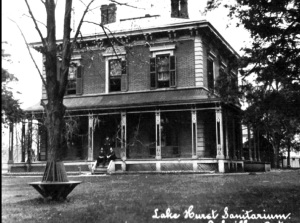
Oakville’s White Star steamship company, whose steamers had plied the waters taking fresh produce into Toronto and returning with day-trippers, was now history – preserved in postcards and tourist photos posted in scrapbooks and albums. The company’s ledger books were stored in the local historic society vaults.
It dawned on MacKendrick that he had been all too successful – the popularity of the lakeshore had waned with the advent of cars and the network of roads, many of which were built by his company.
His roads had dispersed people into the new subdivisions where the attractions of a lake steamer excursion had been trumped by the close convenience of gardens and parks.
The stone gates, house and grounds remain much as they were designed and built between 1909 and 1922 by MacKendrick. The estate was left to Oakville in 1971 by a later owner to be used as a park and art gallery.
_______________
In 2009 I created an Oakville Galleries installation that explored W.G. MacKendrick’s mind-set in the decades before his death. After the First World War he descended from his active role in city-building into an obsessive involvement with predicting the end of time from his reclusive Lakeshore estate.
Before the war MacKendrick was most conscious of time as it related to labour efficiency and materials transport in road building. After coming back from the front he was absorbed with Time in a historical and religious sense as he sought to see the future through the pages of the Bible.
He belonged to the Christian fundamentalist cult called British Israelism whose members believe that the Britain and the United States were founded and are led by the descendants of one of ‘the twelve tribes of Israel’, God’s chosen people.
The central appeal of this fundamentalist cult for MacKendrick was that the Bible offered, albeit in obscure, riddle-like expression, an accurate prediction of the future. The past and the future were measured by a series of divinely ordained series of global events culminating in the Last Judgement.
He repeatedly turned to the Bible to pin point through a British Israelite reading, what would follow the Great War as the next cataclysm drawing the world to its end.
MacKendrick’s retirement home was also a family compound where he waited for the last chapters of history to unfold. His final retreat to this Lakeshore estate was an escape from the rapid urban rhythms and global political sphere that he had once embraced as city builder and servant of the British Empire.
To read more go to Menu: “Paving the Way to Paradise…” Chapter One and Chapter Six.
Images
1. entrance Oakville Galleries in Gairloch Gardens 1366 Lakeshore Road East, former estate of W.G. MacKendrick
2. view of Lake Ontario from public park former garden of W.G. MacKendrick
3.-8 MacKendrick family at regattas ca. 1890s, collection Gordon MacKendrick
9. city of toronto archives fonds 1244 item 0186 Toronto Canoe Club 1910 (detail)
10. Oakville lighthouse, Oakville Historical
Society
11. Yacht in Oakville Harbour, Oakville Historical Society
12. city of toronto archives fonds 1244 item 0186 Toronto Canoe Club 1910 (detail)
13. city of toronto archives fonds 1244 item 163 Hanlan’s Point Hotel & regatta 1907
14.- 17 Oakville Historical Society
18.- 20 details, Fruit Growers’ Association scrapbook with photos glued on ledgers ca. 1900 Oakville Historical Society
21. entrance to a street of homes built within the gates of a former Lakeshore Road estate, Oakville

